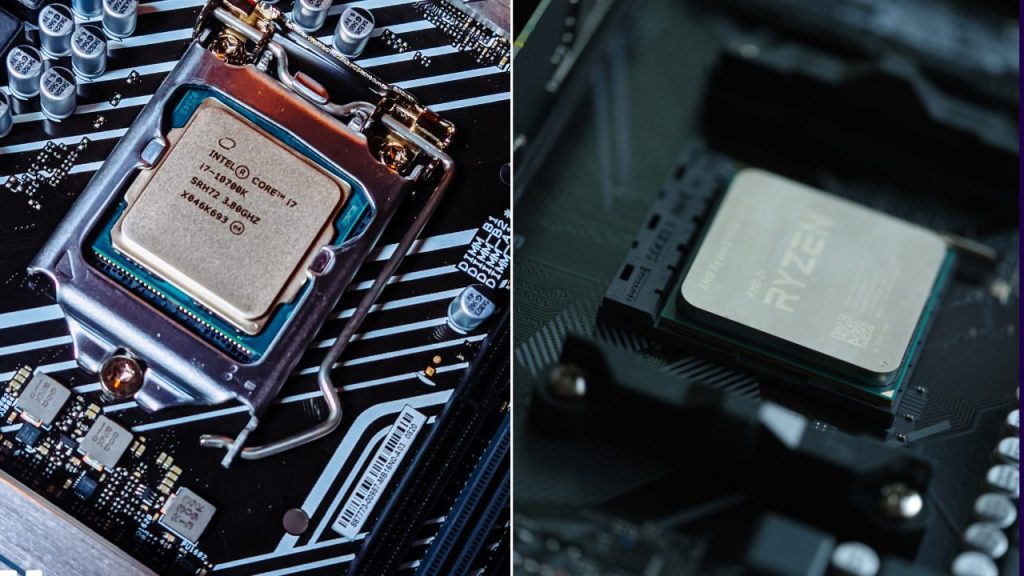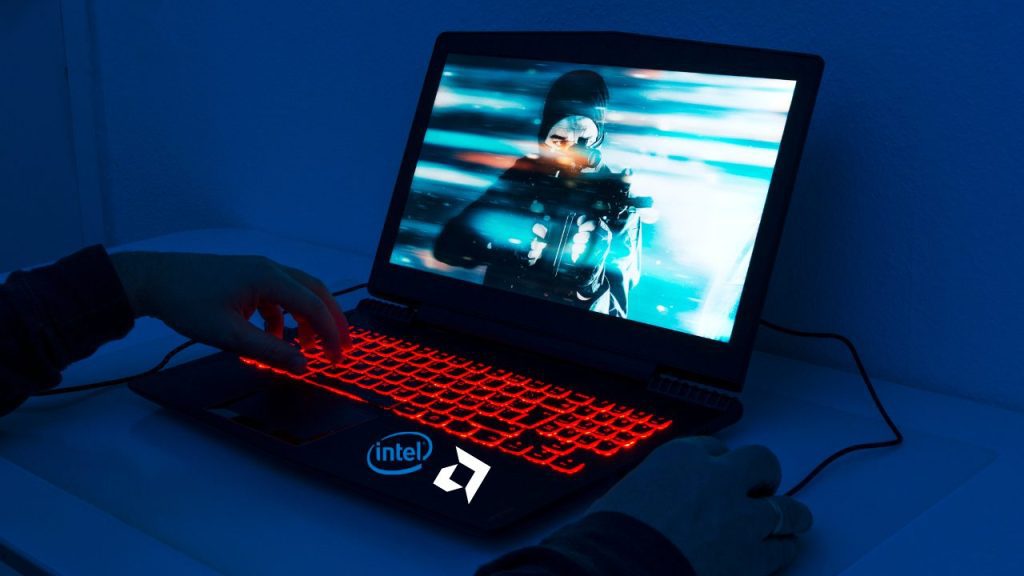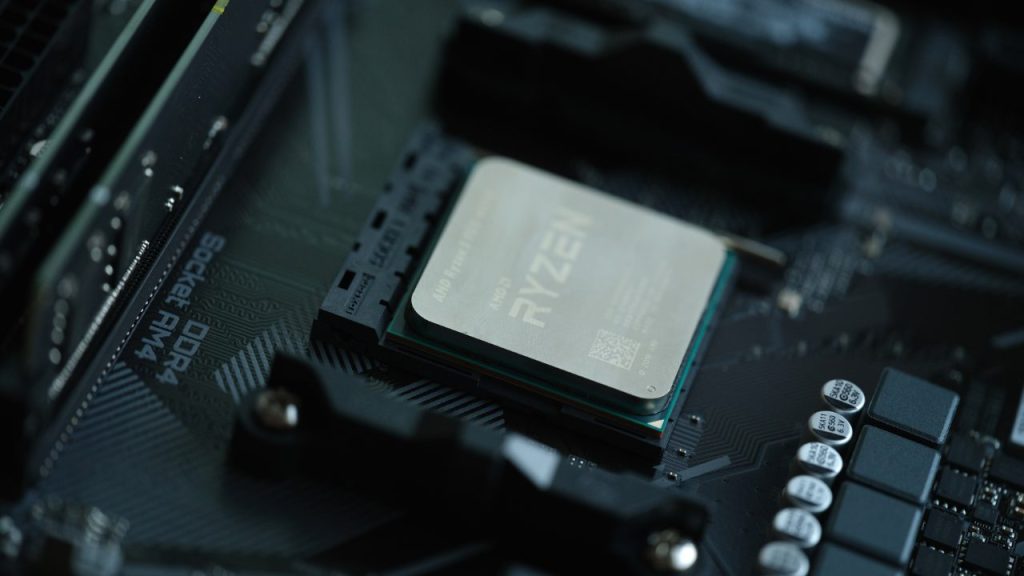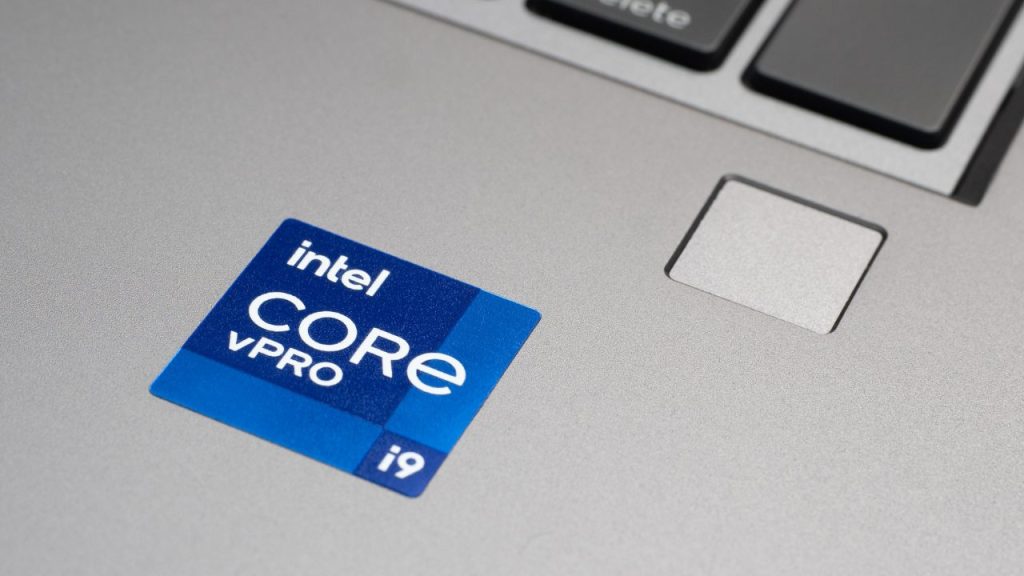You there, with the half-empty bank account and twitchy trigger finger. Don’t even think about clicking “add to cart” on that shiny new Ryzen 9000 CPU or Intel 13th-gen processor just yet – not before arming yourself with the forbidden knowledge within. I have returned from the future year of 2024 with tales of silicon champions and benchmark battles.
Of frame rates and core counts. Of AMD versus Intel. So listen up, because these 100 words could save you hours of hair-pulling buyer’s remorse. Choose wisely, grasshopper. The fate of your future framerates depends on it.
AMD vs Intel: A Brief History of the CPU Wars
Back in the day, choosing a CPU for your gaming rig was simple. You either ponied up for Intel’s premium processors or settled for AMD’s budget-friendly alternatives.

AMD has come a long way since then, releasing powerhouse chips that trade blows with Intel’s best. If you want the ultimate gaming PC in 2024, you’ve got a tough choice.
The Underdogs No More
For years, Intel dismissed AMD as an also-ran. They poured billions into their chip foundries while AMD struggled. What Intel didn’t count on was AMD’s pluck and ingenuity.
Against all odds, AMD released the Athlon in 1999, the first CPU to reach speeds of 1 GHz. Athlon was faster and cheaper than Intel’s offerings, winning over enthusiasts and budget gamers alike.
Intel Strikes Back
Intel wasn’t about to take AMD’s challenge lying down. They released the Pentium 4, a beast of a CPU that reclaimed the performance crown. Not to be outdone, AMD debuted the Athlon 64, the first desktop processor with 64-bit extensions. The back-and-forth continued for over a decade, with each new CPU generation one-upping the last.
The Present and Future
Today, AMD and Intel both offer compelling options for gaming PCs. Intel’s 10th-gen Comet Lake CPUs provide solid performance for the money, while AMD’s Ryzen 3000 series offers more cores and threads for the dollar.
Looking ahead, AMD will likely maintain its lead in core counts, while Intel works to boost clock speeds. Either way, PC gamers will reap the benefits of the decades-long battle for processor supremacy. The future’s so bright, you’re gonna need gaming goggles.
AMD vs Intel for Gaming in 2024: Performance Comparison
By 2024, AMD and Intel will likely be duking it out for gaming CPU supremacy once again. If history is any indication, AMD will probably release yet another processor that provides unrivaled performance for the money. Intel, on the other hand, will assuredly counter with a CPU bearing an absurd number of cores to reclaim the gaming crown.

As a gamer, you’ll be faced with the age-old quandary: AMD or Intel? Do you go for AMD’s budget-friendly and quick CPUs or Intel’s blisteringly fast (and pricey) silicon? There’s no easy answer, but here are some factors to consider:
| Header Cell – Column 0 | Intel | AMD |
|---|---|---|
| CPU Pricing and Value | ✅ | ❌ |
| Gaming Performance | ✅ | ✅ |
| Content Creation/Productivity | ✅ | ❌ |
| Specifications | ✅ | ❌ |
| Overclocking | ✅ | ❌ |
| Power Consumption | ❌ | ✅ |
| Drivers and Software | ✅ | ❌ |
| Process Node | ❌ | ✅ |
| Architecture | ✅ | ✅ |
| Security | ❌ | ✅ |
| Winner: Intel – Total | 7 | 5 |
Price vs Performance
AMD typically offers better value, with speeds nearly matching Intel’s for hundreds less. If every dollar counts in your build, AMD may have the edge. Performance junkies will likely choose Intel’s cutting-edge CPUs and their stratospheric frame rates, budget be damned.
Upgradability
AMD’s CPUs and motherboards are often compatible across generations, so you can easily drop in a new CPU later on. Intel changes sockets frequently, so upgrading typically means swapping your motherboard too—not ideal. On the other hand, Intel’s platforms usually support CPU overclocking better if you’re into that.
Heat and Power
High-end Intel CPUs are power-hungry and run hot, requiring beefy coolers. AMD’s chips are often more energy-efficient, running cooler on smaller coolers. For a quiet system without an industrial-strength cooler, AMD may have the advantage.
In the end, for the ultimate 2024 gaming PC, you can’t go wrong either way. But if every frame and dollar matters, weigh these factors carefully. AMD or Intel—choose your fighter! The battle for gaming CPU supremacy rages on.
AMD vs Intel: Price to Performance Ratio
AMD has long positioned itself as the value option for budget-conscious gamers, and that tradition continues with its latest CPU offerings. If getting the most gigahertz for your gaming dollar is priority one, AMD will serve you well.
| Family | AMD | Intel |
|---|---|---|
| Threadripper – Xeon W | $2,399- $6,499 | $949 – $4,499 |
| AMD Ryzen 9 – Intel Core i9 | $549 – $699 | $538 – $699 |
| AMD Ryzen 7 – Intel Core i7 | $299 -$449 | $298 – $409 |
| AMD Ryzen 5 – Intel Core i5 | $129 – $299 | $157 – $319 |
| AMD Ryzen 3 – Intel Core i3 | $95 – $120 | $97 – $154 |
More affordable, yet still packs a punch
AMD’s Ryzen 5 and Ryzen 7 lines routinely undercut Intel’s Core i5 and i7 CPUs by $50-$100 or more. Yet in many games, especially at higher resolutions, the performance difference is negligible. The savings can then be put toward a better graphics card, more memory, or a larger solid-state drive. For gaming on a budget, AMD’s value proposition is hard to beat.
Overclocking without the “Intel tax”
AMD also reigns supreme for overclockers on a budget. With an inexpensive AMD motherboard and CPU cooler, you can often coax an extra 500MHz or more from a Ryzen processor. Good luck getting those results from an Intel CPU without paying the customary “Intel tax” on overclocking-friendly motherboards and exotic cooling solutions.
Intel for the win?
That said, Intel still claims the performance crown in some areas. In esports titles and other games focused on high frame rates, Intel’s raw CPU horsepower provides an advantage. Intel also offers Thunderbolt 3 support, which is useful for connecting external graphics amplifiers.
And of course, there’s brand cachet—some gamers simply prefer the familiar “Intel Inside.” If budget is no object and you demand the absolute highest frame rates, Intel gets the nod.
But AMD offers a compelling combination of strong gaming performance and affordability that’s hard to ignore. In the end, choosing a CPU comes down to how much you’re willing to spend for a few extra frames per second. For most gamers, AMD’s Ryzen processors will do the job admirably without breaking the bank.
AMD vs Intel Laptops for Gaming: Which Brand Wins?

Performance
When it comes to gaming performance, AMD and Intel are neck and neck these days. AMD’s Ryzen 5000 series can go toe-to-toe with Intel’s latest Core i7 and i9 chips. If raw power is your main concern, you really can’t go wrong either way.
That said, AMD generally offers better value, with more cores and threads for your dollar. So if you’re on a budget, Team Red is probably your best bet.
Battery Life
Historically, Intel has dominated the battery life competition. Their efficient processors and platform optimizations gave them a clear advantage for on-the-go use. But AMD has closed the gap considerably with their latest Zen 3 architecture.
While Intel still has a slight edge, AMD laptops can now last 6-8 hours on a charge, which is plenty for most needs. Unless every minute of battery life matters, I wouldn’t make my choice based solely on this factor.
Graphics
When it comes to integrated graphics, AMD is the undisputed champion. Their Vega and Radeon graphics provide significantly better performance than Intel’s UHD graphics.
For casual gaming and GPU-accelerated tasks, an AMD APU can get the job done without requiring a bulky dedicated graphics card. If you plan on more serious gaming, though, you’ll want a laptop with an NVIDIA or AMD Radeon discrete GPU either way.
Compatibility
Compatibility used to be a concern with AMD platforms, but those days are largely behind us. Almost all modern games, applications, and operating systems support both Intel and AMD processors equally well. The only potential issue is with certain creative and productivity software that was optimized for Intel’s platform.
However, AMD’s market share gains have led most developers to ensure full compatibility and optimization for Ryzen and Radeon as well. So when all is said and done, both Intel and AMD make killer gaming laptops. I would base my choice primarily on performance, price, and specific needs.
If you want maximum power for minimum spend, AMD is probably your best bet. If battery life and general-purpose performance are higher priorities, Intel may have an edge. But no matter which brand you choose, you really can’t go wrong. The future is bright for PC gaming!
AMD vs Intel: Power Consumption and Thermal Design
Coming in hot (literally) with AMD’s latest RyzenTM line-up, their 7nm manufacturing process runs so efficiently that you’ll barely notice the extra heat. Unlike Intel’s aging 14nm designs that double as space heaters, AMD’s chips are cool customers. If you value stealth over sheer horsepower, AMD has an Intel beat.
Not that Intel is a complete slouch in the power department. Their new 10th gen Comet Lake CPUs can hold their own, though you may want to invest in a beefy cooler to prevent thermal throttling under heavy loads. Intel’s obsession with clock speed means their chips run hot, hot, hot! You’ll be cranking the AC just to compensate.
Speaking of clocks, AMD’s impressive overclocking potential means extra performance is just a few clicks away in your motherboard’s BIOS. With a decent aftermarket cooler, you can push most Ryzen chips well past their stock speeds. Meanwhile, Intel locks down their K-series chips, limiting overclocking to the silicon lottery. You pay your money, you take your chances.
The power draw is another win for Team Red. AMD’s 7nm process sips daintily at the juice, even when overclocked. Your PSU and energy bill will thank you. Intel’s power-hungry chips, on the other hand, demand a robust power supply and rate hike from the electric company. Every frame per second comes at a cost, I suppose.
If staying on the cutting edge of technology at an affordable price is important to you, AMD is the obvious choice for your 2024 gaming build. Their Ryzen line-up offers blazing performance, miserly power draw, and thermals any gaming enthusiast can appreciate. While Intel continues rehashing its ancient architectures, AMD is innovating at light speed. The future is Zen, so choose your fighter wisely!
AMD vs Intel: Platform and Upgrade Path
So you want to build a gaming PC, do you? The first big choice is which team you want to power your rig: Team Red (AMD) or Team Blue (Intel). If upgradeability and future-proofing are a concern, AMD currently has the edge.
AMD’s AM4 socket has legs.
AMD’s AM4 socket has been around since 2017 and still supports the latest Ryzen 5000 series CPUs. This means if you build an AM4-based system today, you’ll have the option to drop in a newer CPU down the road without needing a whole new motherboard.
Intel, on the other hand, has a nasty habit of switching sockets with every CPU generation. If you want to upgrade in a few years, there’s a good chance you’ll be paying through the nose for a new mobo.
PCIe 4.0 support.
AMD was the first to be the PCIe 4.0 party, with support dating back to their X570 chipset in 2019. PCIe 4.0 provides double the bandwidth of PCIe 3.0, meaning faster NVMe SSDs and graphics cards. Intel only recently added PCIe 4.0 support with their Z490 chipset. If future-proofing is the goal, AMD’s extra year of support could come in handy.
Overclocking and power draw.
If overclocking is your thing, both AMD and Intel have you covered with unlocked “K” SKUs and robust BIOS options for tweaking settings. However, AMD’s Ryzen chips are often more power efficient, running cooler and drawing less power than comparable Intel parts. For small form factor builds where heat is a concern, Team Red may have a slight advantage.
At the end of the day, AMD and Intel both make fantastic gaming CPUs. But if upgradability, PCIe 4.0 support, and thermals are a priority, AMD’s AM4 platform currently has a leg up on the competition. The choice is yours—just know that whichever side you choose, endless frames and high-fidelity gaming await. Now get out there and start building your beast of a machine!
AMD vs Intel: Overclocking Potential
When it comes to overclocking, AMD and Intel offer very different experiences. With Intel, you’re largely at the mercy of the silicon lottery. Some chips will hit 5GHz without breaking a sweat, while others wheeze and sputter past 4.8GHz. If you get a dud, too bad—Intel locks down their chips to prevent any serious overclocking.
AMD, on the other hand, all but encourages you to overclock. They build overclocking potential right into their chips, with unlocked multipliers on most models. This lets you crank up clock speeds with a few clicks in your motherboard’s BIOS. AMD’s chips also tend to run a bit hot, so they pack beefy stock coolers meant to handle the extra heat from overclocking.
The choice comes down to control vs convenience. With Intel, you get what you get. With AMD, the reins are in your hands. Want an easy 5GHz? AMD’s got you covered. Feel like pushing past 5.2GHz just to say you did? Also possible with the right cooling. Of course, with great power comes great responsibility—it’s easier to fry an AMD chip if you push it too far. But for the overclocking thrill-seeker, AMD can’t be beat.
Overclocking is a game of diminishing returns. Each 100MHz you gain requires more voltage, more heat, and more instability. But for bragging rights alone, that final 5.3GHz—no matter how impractical—is worth it. And only with AMD will you have a shot at claiming that crown. So if overclocking is your passion, AMD is your brand. They give you the control, the cooling, and the chips to push clocks to the limit. Sure, you may end up with a $500 paperweight. But think of the glory! AMD FTW.
Best AMD Budget CPUs
AMD has always been the budget-friendly choice for gamers, and their latest CPU offerings prove they still know how to deliver serious performance at wallet-friendly prices. If you’re looking to build an affordable yet capable gaming rig, AMD’s budget CPUs should be at the top of your list.

AMD’s Ryzen 5 series offers superb performance for the money. The 6-core Ryzen 5 3600X provides fast clock speeds and smooth gameplay for under $200, while the Ryzen 5 5600X ups the ante with blazing fast single-core performance that outpaces Intel’s offerings for a bit more. For well under $300, either chip will drive high frame rates in all the latest games without breaking the bank.
Feeling extra thrifty? AMD’s Ryzen 3 processors start at around $100 and can still run modern titles at playable frame rates. The quad-core Ryzen 3 3300X offers performance on par with Intel’s $200 i5-9400F for half the price.
You won’t be playing on max settings, but for casual and eSports gaming the Ryzen 3 series punches well above its weight class. Of course, you’ll need to pair these CPUs with a capable graphics card to enable high-fidelity gaming. But with the money saved on your CPU, you’ll have plenty left in your budget for a solid GPU.
AMD’s budget-friendly CPUs may lack some of the bells and whistles of their high-end counterparts, but they offer an unbeatable combination of performance, value, and upgradability that budget-conscious gamers crave. For gaming on a shoestring budget in 2024, AMD’s affordable yet capable Ryzen processors simply can’t be beat.
Best Intel Budget CPUs
When building a gaming PC on a budget, Intel’s value-focused Core i3 and Pentium CPUs are appealing options. These affordable chips lack the raw power of Intel’s Core i5 or i7 CPUs but can still run modern games at acceptable frame rates, especially when paired with a solid graphics card.

If cash is tight in 2024 and you’re looking to keep costs down, Intel’s Pentium Gold G6400 is your best bet. This dual-core CPU won’t blow you away with its performance, but for well under $100, it handles most eSports titles and less demanding games without issue. Just don’t expect to run graphics-intensive AAA games at high settings.
Spending a bit more for a quad-core Core i3-10105F gets you significantly better performance for not much more dough. This CPU can run even relatively new games at medium to high settings while maintaining very playable frame rates. With a boost up to 4.4 GHz, the i3-10105F is a solid budget-friendly option for building an entry-level gaming PC that will last you a few years.
If you’ve got some extra cash in your pocket, spring for Intel’s 6-core Core i5-10400. This mid-range CPU delivers excellent performance for most games and will handle VR and streaming with no problem. You’ll pay slightly more for the i5-10400, but its combination of high clock speeds, 6 cores, 12 threads, and 12MB of cache make it worth the extra cost.
No matter which Intel CPU you choose for your budget gaming build, you really can’t go wrong. Any of these options provide good value and performance for the money. Just keep your expectations in check, overclock when possible, and pair your CPU with a graphics card suited to your needs. With the right components surrounding it, even Intel’s most affordable Pentium and Core i3 chips can power a perfectly capable gaming PC.
Choosing the Right CPU for Your Custom Gaming PC
So you’ve spaced out the rest of your rig—monster graphics card, speedy solid-state drive, fancy case with RGB everything. But you’re still stuck on that age-old question: AMD or Intel for the processor? In 2024, the choice comes down to raw power versus value.
If money’s no object and you want the worst of the bad, Intel’s latest 12th-gen CPUs will give you bragging rights at your next LAN party. We’re talking 16 cores of pure, unadulterated power that can handle anything from competitive esports to graphically intensive AAA titles without breaking a sweat. The only downside is that Intel’s top chips demand a premium price and require beefy cooling to unleash their full potential.

Alternatively, you could save some cash with AMD’s Ryzen 7000 series and still enjoy kick-ass performance for most games. AMD continues to offer more cores for less coin than Intel, and their 7nm manufacturing process results in lower power draw and heat output.
The Ryzen 9 7950X, with 16 cores and 32 threads, provides nearly as much grunt as Intel’s best for hundreds less. For 60% of the price, you’ll get 90% of the performance. Now that’s value. At the end of the day, choosing between AMD and Intel comes down to how much you’re willing to spend to shave a few extra milliseconds off your frame rates.
If money’s tight, AMD’s latest Ryzen chips are your best bet for a superb gaming experience without emptying your wallet. But for bragging rights and the ultimate in performance, Intel’s 12th-gen Core i9 will give you the edge—if you can foot the bill. The choice is yours!
Conclusion
So which fighter will you choose for your gaming rig in 2024 – the blue giant or the red underdog? When it comes to CPUs, the choice ain’t always easy or obvious. But if you want the best bang for your gaming buck, you gotta dig into the specs and benchmarks.
Do your homework and you’ll build a screamin’ fast PC. Pick wrong and you’ll be stuck with a slowpoke. Sure, fanboys will preach one brand over the other. But you gotta think for yourself. Weigh your options, crunch some numbers, and then throw down your cash for the champion CPU. Who will it be? The decision is yours, champ. Just make it a good one.
Read More : Snapdragon X Elite : Qualcomm’s Newest Laptop Processor
 Oko Dot All In One Technology Solutions By Likhon Hussain
Oko Dot All In One Technology Solutions By Likhon Hussain
